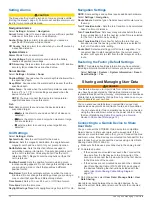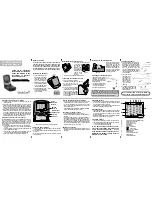
Garmin ClearVü
Transducer Transom/
Trolling Motor Mount
Installation Instructions
Important Safety Information
WARNING
See the
Important Safety and Product Information
guide in the
chartplotter or fishfinder product box for product warnings and
other important information.
You are responsible for the safe and prudent operation of your
vessel. Sonar is a tool that enhances your awareness of the
water beneath your boat. It does not relieve you of the
responsibility of observing the water around your boat as you
navigate.
CAUTION
Failure to install and maintain this equipment in accordance with
these instructions could result in damage or injury.
Always wear safety goggles, ear protection, and a dust mask
when drilling, cutting, or sanding.
NOTICE
When drilling or cutting, always check what is on the opposite
side of the surface.
This equipment should be installed by a qualified marine
installer.
To obtain the best performance and to avoid damage to your
boat, you must install the Garmin
®
device according to these
instructions.
Read all installation instructions before proceeding with the
installation. If you experience difficulty during the installation,
contact Garmin Product Support.
Tools Needed
• Drill and drill bits
• Number 2 Phillips screwdriver
• Masking tape
• Marine sealant
Preparing the Transducer for Long-Term Exposure to
Water
NOTICE
Do not use acetone or acetone-based products on the
transducer. Acetone damages the plastic transducer housing.
When you install a transducer on a boat that spends a
significant amount of time in the water, you should coat the
transducer and mounting hardware with a water-based anti-
fouling paint to prevent marine growth.
1
Lightly sand the transducer and mounting hardware with a
fine-grit abrasive pad.
2
Wipe the transducer and mounting hardware with isopropyl
alcohol.
3
Apply water-based anti-fouling paint to the transducer and
mounting hardware.
Mounting Consideration
To ensure peak performance with the lowest noise and
interference, you should route the transducer cable away from
ignition wires, house batteries and wires, trolling motor batteries
and wires, and high-energy wires such as radar, audio amplifier,
and autopilot pump wires.
Installing the Transducer on a Transom
Mounting Location Considerations
• The transducer should be mounted parallel to the water line.
• The transducer should be mounted as close to the center of
the boat as possible.
• If your propeller moves clockwise when the boat moves, the
transducer should be mounted on the starboard side.
• If your propeller moves counter-clockwise when the boat
moves, the transducer should be mounted on the port side.
• The transducer should not be mounted behind strakes, struts,
fittings, water intake or discharge ports, or anything that
creates air bubbles or causes the water to become turbulent.
The transducer must be in clean (non-turbulent) water for
optimal performance.
• The transducer should not be mounted in a location where it
might be jarred when launching, hauling, or storing.
• On single-drive boats, the transducer must not be mounted in
the path of the propeller.
The transducer can cause cavitation that can degrade the
performance of the boat and damage the propeller.
• On boats with outboard or inboard/outboard motors, the
transducer should be mounted at least 38 cm (15 in.) from
the propeller.
• On twin-drive boats, the transducer should be mounted
between the drives, if possible.
Assembling the Transducer with a Transom Mount
Bracket
1
Attach the mount
À
to the transducer
Á
with the included
star washers
Â
, and screws
Ã
.
2
Attach the mount to the bracket
Ä
with the bolt
Å
, rubber
washer
Æ
, flat washer
Ç
, and lock nut
È
.
NOTE:
The bolt should be tight enough to hold the
transducer in place when the boat moves at high speed, but
loose enough to allow the transducer to pivot out of the way if
the transducer hits an obstruction.
February 2017
Printed in Taiwan
190-02116-02_0A























